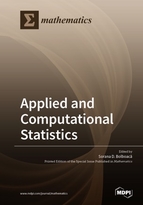Applied and Computational Statistics
A special issue of Mathematics (ISSN 2227-7390).
Deadline for manuscript submissions: closed (30 April 2019) | Viewed by 23509
Special Issue Editor
Interests: applied and computational statistics; molecular modeling; genetic analysis; statistical modeling in medicine; integrated health informatics system; medical diagnostic research; statistical inference; medical imaging analysis; assisted decision systems; research ethics; social media and health information; evidence-based medicine
Special Issues, Collections and Topics in MDPI journals
Special Issue Information
Dear Colleagues,
The researches on statistical population, sample, or model have application in all research areas and are conducted to gain knowledge for real-world problems. The increase of the power of calculation opens the path to computational statistics, translation of algorithms, implementation of statistical methods and computer simulations. These areas are developing rapidly, providing solutions to multidisciplinary, interdisciplinary, or transdisciplinary topics. The goal of this Special Issue is to present a collection of articles on applied and computational statistical methods, methodologies, applications and software, a bridge between statistic theory and its applications.
Submissions in areas of applied and computational statistics are invited, reporting (but not limited to):
- Methods (including resampling, optimization, Monte Carlo, regression, artificial neural networks, etc.)
- Algorithms (including design, analysis, and validation) for numerical analysis, statistics, image processing, etc.
- Software (including different implementations, software validation, software errors, etc.)
- Data analysis (including inferential statistics, distribution theory, stochastic analysis, etc.)
- Big data (analysis, management, retrieval, etc.)
- Data mining and data science (databases, visualization, etc.)
- In silico approaches, methodologies and results (including with parallel and distributed computing)
Are welcomed high-quality original theoretical and applied research papers, reviews, articles crossing biological and medical sciences, computer science and information technology, engineering, social sciences, etc.
Prof. Dr. Sorana D. Bolboaca
Guest Editor
Manuscript Submission Information
Manuscripts should be submitted online at www.mdpi.com by registering and logging in to this website. Once you are registered, click here to go to the submission form. Manuscripts can be submitted until the deadline. All submissions that pass pre-check are peer-reviewed. Accepted papers will be published continuously in the journal (as soon as accepted) and will be listed together on the special issue website. Research articles, review articles as well as short communications are invited. For planned papers, a title and short abstract (about 100 words) can be sent to the Editorial Office for announcement on this website.
Submitted manuscripts should not have been published previously, nor be under consideration for publication elsewhere (except conference proceedings papers). All manuscripts are thoroughly refereed through a single-blind peer-review process. A guide for authors and other relevant information for submission of manuscripts is available on the Instructions for Authors page. Mathematics is an international peer-reviewed open access semimonthly journal published by MDPI.
Please visit the Instructions for Authors page before submitting a manuscript. The Article Processing Charge (APC) for publication in this open access journal is 2600 CHF (Swiss Francs). Submitted papers should be well formatted and use good English. Authors may use MDPI's English editing service prior to publication or during author revisions.
Keywords
- Statistical and computational methods
- Statistical and computational methodologies and approaches
- Statistics algorithms and software
- In silico statistical approaches
- Data analysis and analytics
- Big data and data mining






